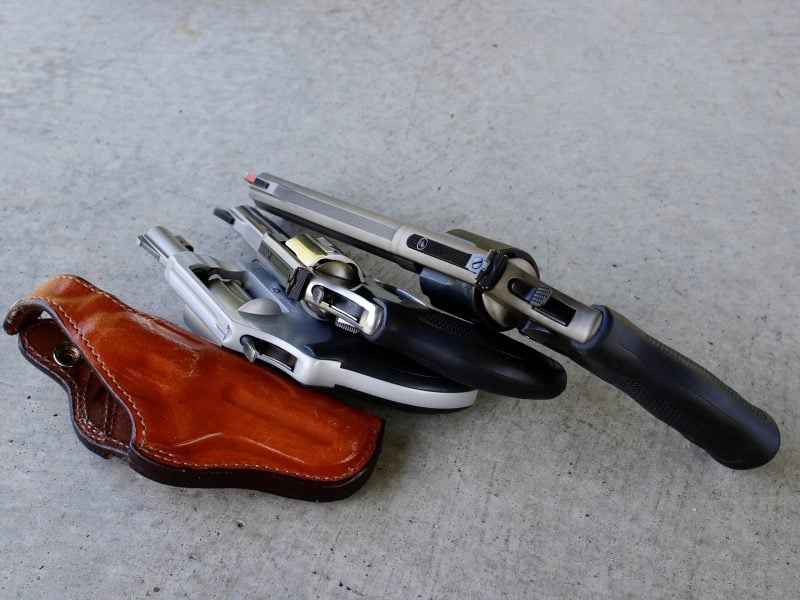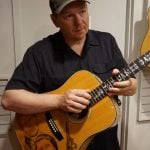The first gun I ever really learned to shoot was an Iver Johnson .38 S&W. Ever since, I’ve had a deep respect for both the .38 caliber rounds and the wheel gun. At a recent range trip, I took out three Smith & Wessons to see if the differences in basic barrel length might make a noticeable difference in how they performed in some basic drills.
The Guns
I own three Smiths. The smallest is a Model 637. This is a very traditional snub-nosed five-shot .38. The sights are fixed and milled in and the grip is short. I carry it in my pocket at times, in the inside pocket of a coat, and in a variety of IWB and OWB holsters.

Coming in slightly larger, and with the capability of handling the .357 round, is the Model 60. This has more grip and more barrel, and the sights are adjustable and designed for greater accuracy.
At the large end is my beastly Model 686. This gun is a S&W staple, but mine has been given the WMD Guns Melonite and Black Nitride treatment. This one is a seven-shot, which still throws me from time to time. I can count to six, but seven is right out.
Their Respective Sizes
Both the Model 60 and the Model 637 are J-frame Smiths. These are smaller. The Model 60 fits my hand perfectly. The 637 has a shorter grip meant for concealed carry, so my pinky falls below the grip.
The 686 is an L-frame; much bigger and heavier. These stainless guns tend to have full lugs under the barrel, which helps to hold down muzzle-flip. The extra weight makes these really easy-shooting guns, especially when shooting .38s.
The Basic Test
To begin, I wanted a baseline for how I fired each gun in a controlled defensive scenario. I bought the 637 for EDC. The Model 60 is a favorite for hikes where I’m more conscious of weight. If I’m hunting or wandering in the woods, I’ll often have the 686 on my hip.
I began from a low-ready position. When the timer went off, I fired five rounds at center-mass of a torso target from 25 feet. I had no intention of shooting controlled groups as reviewers often do when punching paper in the hopes of extolling the virtues of accuracy.

Instead, I wanted to see where I was hitting the target when shooting fast, as one might in an adrenaline-fueled defensive scenario. Each shot was fired double-action, as rapidly as possible without sacrificing control.
As the two smaller revolvers only hold five rounds, you’ll need to work on reloads, too. Reloading with a speedloader is fast on the range, but more cumbersome for EDC. Speedstips are a bit more practical.
The Snub-Nose Snub
The 637 is jumpy. In each test, I hit high on the target. Because of the short grip and the short barrel, muzzle flip was noticeable.
The Model 60
Why isn’t the Model 60 in this 3″ configuration more popular? It flies. The grip is large enough to hold without being so large that it isn’t concealable.
My results with the Model 60 were more in line with my intentions. The gun is easier to control.

The 686
Despite being the smoothest of the three guns, I tended to pull a bit low and left with the 686. It was the fastest of the three, as it stays on target exceptionally well.
A More Complicated Barrel Length Test
After running this drill a number of times, I placed some clays on the berm at 75 yards. Shooting from a standing position, I tested each gun at this distance. Even when I didn’t break the clay itself, I could see the dirt splash on the berm.
The snub-nosed Smith wasn’t consistent at this distance. No surprise. The Model 60 adds much more consistency, but I still struggled to dial it in exactly. I could break clays, but it wasn’t easy.
I’m sure everyone reading this is shocked that the 686 puts up the best accuracy results. Rather than firing three or four shots to walk one in, I could connect with much more regularity on the first shot.

How does barrel length change muzzle velocity?
For ammo, I used Federal American Eagle Super +P. As .38 Special goes, these are effective JHPs. The light projectile helps it reach the 1130 FPS advertised speeds in controlled tests. Real-world revolvers always trim those numbers down some.
To be all scientific, I could have tested these on a chronograph. But this summer has been beastly hot in Arkansas, and life’s too damn short. And the data already exists.
Even the hottest .38 loads are going to run under 1,000 FPS from a revolver with a 1.88″ barrel. There’s some pressure loss through the cylinder gap, and a fireball that shows where the rest of the powder goes.
Most loads will run between 800 and 950 fps. Bump the barrel length to 3″ and you will see a modest increase. While most will run under or around 950, some will push the 1050 fps mark. That’s still below the supersonic point.
In order to get up to the speeds you would see from most 9mm, you need more barrel length. Even the 686 with .38 struggles to push lead above the supersonic point.

Had This Been 100% Apples to Apples
I should have found a snub-nosed .357. Smith makes them, of course — the 60 comes in a shorted configuration, as does the 340. I could run this entire exercise again with .357s instead of .38s, but I didn’t.
And in the end, one factor that I find made the most difference — and this is so obvious — is the holster in which you carry the gun. The shorter the gun, the more adept it is inside the waistband. And I tend to carry the 686 in a cross-draw position.
The fastest gun for me is the Model 60 in its three-inch form, which I tend to wear strong-side. Even in a thumb-snap holster, I can get it on target faster than I can a gun from the IWB position or cross-draw.
So maybe this test on revolver barrel length isn’t as scientific as it could have been. But it is telling. How do the results change my thoughts on what I might carry? It won’t. The best gun to carry is the one you will actually carry, and that means it has to be easy.
For me, that means the snub-nosed J-frame, most of the time. It is also the one I like to shoot the least, which is reason to practice regularly.


